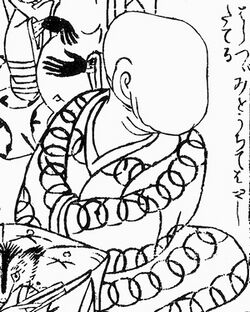Unsolved:Noppera-bō
The noppera-bō (のっぺらぼう), or faceless ghost, is a Japanese yōkai that looks like a human but has no face. They are sometimes mistakenly referred to as a mujina, an old Japanese word for a badger or raccoon dog.[1] Although the mujina can assume the form of the other, noppera-bō are usually disguised as humans. Such creatures were thought to sometimes transform themselves into noppera-bō in order to frighten humans. Lafcadio Hearn used the animals' name as the title of his story about faceless monsters, probably resulting in the misused terminology.
Noppera-bō are known primarily for frightening humans, but are usually otherwise harmless. They appear at first as ordinary human beings, sometimes impersonating someone familiar to the victim, before causing their features to disappear, leaving a blank, smooth sheet of skin where their face should be.
In literature and folktales
Often, a noppera-bō would not actually exist, but was the disguise of a mujina, a fox kitsune, or a tanuki.[2] In Showa 4 (1767), in the kaidan collection Shinsetsu Hyakumonogatari, there were stories that told of how in Nijugawara in Kyoto (near the Nijo-ohashi bridge in the Nakagyō-ku, Kyoto), a monster called noppera-bō appeared and those that were attacked by it would have several thick hairs attached to their clothing, indicating that it was the disguise of some kind of animal.[3] However, sometimes their real identity is not known, and in the Kanbun 3 (1663) kaidan collection Sorori Monogatari, it was written that in the Oike-cho of the capital (now Nakagyō-ku, Kyoto), there appeared a noppera-bō with a height of about 7 shaku (about 2.1 meters), but nothing was written about what its true identity was.[4] They are also said to appear in folktales in the Osaka Prefecture[5] and Kotonami, Nakatado District, Kagawa Prefecture among other places.[6]
The Mujina of the Akasaka Road
The most famous story of a noppera-bō is "Mujina" in Lafcadio Hearn's book Kwaidan: Stories and Studies of Strange Things. The story tells of a man who, travelling along the Akasaka road to Edo, comes across a young woman in a remote location near Kunizaka hill, crying and forlorn. After he attempts to console the young woman and offer assistance, she turns to face him, startling him with the blank countenance of a faceless ghost. Frightened, the man proceeds down the road for some time, until he comes across a soba vendor. Stopping to relax, the man tells the vendor of his encounter, only to recoil in horror as the soba vendor strokes his face, becoming a noppera-bō himself. It turns out that all of these noppera-bō are really just mujina in disguise.
See also
- Kuchisake-onna ("Slit Mouth Woman"), a Japanese urban legend about a disfigured woman
- Spirited Away, a 2001 Japanese animated film featuring a character known as "Noh-Face"
- Kiyomi Haunterly, a Japanese faceless ghost in Monster High
- Faceless (disambiguation)
References
- ↑ Spettoli, Letizia (2017-07-03). "Mujina: la leggenda giapponese dello spirito senza volto" (in it-IT). https://www.notizie.it/mujina-leggenda-giapponese-spirito-senza-volto/.
- ↑ 村上健司編著 (2005). Kwai books. 角川書店. pp. 255頁. ISBN 978-4-04-883926-6.
- ↑ 高古堂小幡宗佐衛門 (1993). "新説百物語". in 太刀川清. 国書刊行会. pp. 216頁. ISBN 978-4-336-03527-1.
- ↑ (unknown) (1989). "曾呂利物語". in 高田衛. Iwanami bunko. 中. Iwanami Shoten. pp. 63–65頁. ISBN 978-4-00-302572-7.
- ↑ 山川隆平. "Error: no
|title=specified when using {{Cite web}}". International Research Center for Japanese Studies. http://www.nichibun.ac.jp/YoukaiCard/2180483.shtml. - ↑ 北條令子 (August 1985). 香川の民俗 (香川民俗学会) (通巻44号): 7頁.
External links
- Noppera-bo (No Face) at ScaryForKids
- Entry on "nopperabou" at The Obakemono Project
- Lafcadio Hearn's story at Monogatari.org
- Pierre Wayser's flash video of the mujina story (in French)
- webpage regarding the 1959 and 1981 reports of the Waialae Mujina
- Discussion of the confusion of terms brought about by the titles of Hearn's stories.
 |


